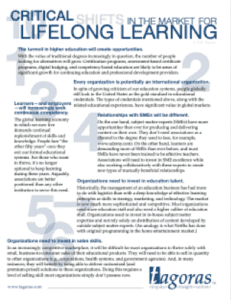As a new year approaches, it’s important for us as learning leaders to think about what we will do to thrive, not just in 2017, but also in the years to come.
In this episode of the Leading Learning podcast, Celisa and Jeff discuss a resource they developed some time ago, 10 Critical Shifts in the Market for Lifelong Learning, which highlights trends that all leaders in the business of lifelong learning, continuing education, and professional development need to have in the forefront of their minds as they develop a strategy for achieving success in this rapidly evolving market.
To tune in, just click below. To make sure you catch all of the future episodes, be sure to subscribe by RSS or on iTunes. And, if you like the podcast, be sure to give it a tweet!
Listen to the Show
Read the Show Notes
[00:20] – Thank you to Avilar, which as the sponsor of our recent Webinar “LMS Selection: Mastering the Process, Avoiding the Pitfalls” is also the sponsor of this episode of the Leading Learning podcast.

[00:55] – A preview of what will be covered in this podcast where Celisa and Jeff discuss a document they created a while back, 10 Critical Shifts in the Market for Lifelong Learning.
[2:00] –
1. The turmoil in higher education will create opportunities.
With the value of traditional degrees increasingly in question, the number of people looking for alternatives will grow.
Certification programs, assessment-based certificate programs, digital badging, and competency-based education are likely to be areas of significant growth for continuing education and professional development providers because people are going to begin questioning whether college is the best route.
Some of these opportunities might also be partnerships with higher education, not just offering the alternatives to higher education.
(You may even want to go so far as to consider whether associations could replace college!)
[03:45] –
2. Every organization is potentially an international organization.
In spite of growing criticism of our education systems, people globally still look to the United States as the gold standard in educational credentials.
The types of credentials mentioned above, along with the related educational experiences, have significant value in global markets.
It doesn’t matter how small you are, you can still have a global presence.
And if you don’t want to think internationally, if you are a state-level organization, you can now be a national organization. Basically, you need to think beyond your traditional borders.
[04:56] –
3. Learners—and employers —will increasingly seek continuous competency.
The global learning economy in which we now live demands continual replenishment of skills and knowledge.
People face “the other fifty years” once they exit our formal educational systems.
For those who want to thrive, it’s no longer optional to keep learning during these years.
Arguably, associations are better positioned than any other institution to serve this need.
There are also commercial providers who are helping to meet this need – we interviewed Kelly Palmer, CEO of Degreed on a previous podcast about this.
[06:55] –
4. Relationships with SMEs will be different.
On the one hand, subject matter experts (SMEs) have more opportunities than ever for producing and delivering content on their own.
They don’t need associations as a channel to the degree they used to (see, for example, https://www.udemy.com and our interview with Shelley Osborne, VP of Learning at Udemy).
On the other hand, learners are demanding more of SMEs than ever before, and most SMEs have never been trained to be effective teachers.
Associations will need to invest in SME excellence while also working collaboratively with these experts to create new types of mutually beneficial relationships.
See also our post on the rise of the eSME.
[09:01] –
5. Organizations need to invest in education talent.
Historically, the management of an education business has had more to do with logistics than with a deep knowledge of effective learning principles or skills in strategy, marketing, and technology.
The market is now much more sophisticated and competitive. Most organizations need more education staff and also need a higher caliber of education staff.
Organizations need to invest in in-house subject matter expertise and not rely solely on distribution of content developed by outside subject matter experts.
An analogy is what Netflix has done with original programming in the home entertainment market.
[11:18] –
6. Organizations need to invest in sales skills.
In an increasingly competitive marketplace, it will be difficult for most organizations to thrive solely with retail, business-to-consumer sales of their educational products.
They will need to be able to sell in quantity to other organizations (e.g., corporations, health systems, and government agencies).
And, in many instances, they will benefit by being able to deliver customized (and premium-priced) solutions to these organizations. Doing this requires a level of selling skill most organizations simply don’t possess now.
[12:50] –
7. Demand for demonstrable impact will grow.
Given the scarcity of time that most people feel and the proliferation of free and low-cost learning experiences the Web has made possible, both learners and employers increasingly want evidence that your educational programs move the dial—especially if you want them to pay.
Our research suggests that most organizations aren’t currently measuring educational impact to any significant degree.
That needs to change.
We believe that initiatives in the medical field that tie to quality improvement and performance improvement may eventually set the standard in this area.
Make sure to check out our podcast episode on the topic of impact.
[14:19] –
8. Knowledge management and education are merging.
We’ve seen evidence of this merger repeatedly in client engagements over the past two years. As part of the richer understanding of learning we now have, organizations want to empower learners to not only participate in formal education experiences but also to rapidly find documents, videos, discussions, and the wide range of other knowledge artifacts they produce and manage.
Frankly, technology vendors have been slow to rise to this challenge, but we expect to see more focus on these capabilities in the coming years.
[16:07] –
9. Blurring and blending will define the user experience.
The rapid convergence of mobile computing, social media, traditional media like television, and emerging wearable technologies is leading to “always on” learning.
Information flows with increasing ease from device to device and back. Educational purchases can be made while standing in line at Starbucks and consumed while flying, or taking the metro.
With the spread of approaches like flipped learning, the lines between the classroom and the screen are blurring.
Having a plan for connecting with members and customers where they are has become critical.
[18:25] –
10. RISC is more essential than ever.
The ability to combine Rapid Intelligence with Strategic Confidence (RISC) will become increasingly critical.
We’ve seen again and again that the winners in specific learning markets are able to detect market trends early and respond in strategic ways.
A variety of tools—from Web and social media analytics, to e-mail statistics, to low-cost feedback systems like iPerceptions (which utilizes a 4Q framework)—can be used to extend and strengthen traditional, less agile market research methods – one tool we created and use is the Market Insight Matrix.

In general, organizations need to get more adept at using these tools, testing new ideas quickly, and moving to full implementation with decisiveness.
[21:00] – Wrap-Up
Thanks again to Avilar for sponsoring of this episode of the Leading Learning podcast.
We encourage you to leave a comment at the bottom of this page to share what you have been doing relative to these shifts, what other major shifts you are seeing, and what you’re planning on doing in the coming years to make sure you capitalize on these opportunities in the market for lifelong learning.
If you are getting value from the Leading Learning podcast, be sure to subscribe by RSS or on iTunes. We’d also appreciate if you give us a rating on iTunes by going to https://www.leadinglearning.com/itunes.
Also, please tell others about the podcast. Go to https://www.leadinglearning.com/share to share information about the podcast via Twitter, or send out a message on another channel of your choosing with a link to https://www.leadinglearning.com/podcast.
[22:53]- Sign off
See also:


Leave a Reply